On View
The Essentials: 5 Key Works From Simone Leigh’s Revelatory Exhibition at the ICA Boston and Why They Matter
ICA Boston is currently exhibiting works from Simone Leigh's 2022 Venice Biennale in the U.S. for the first time.
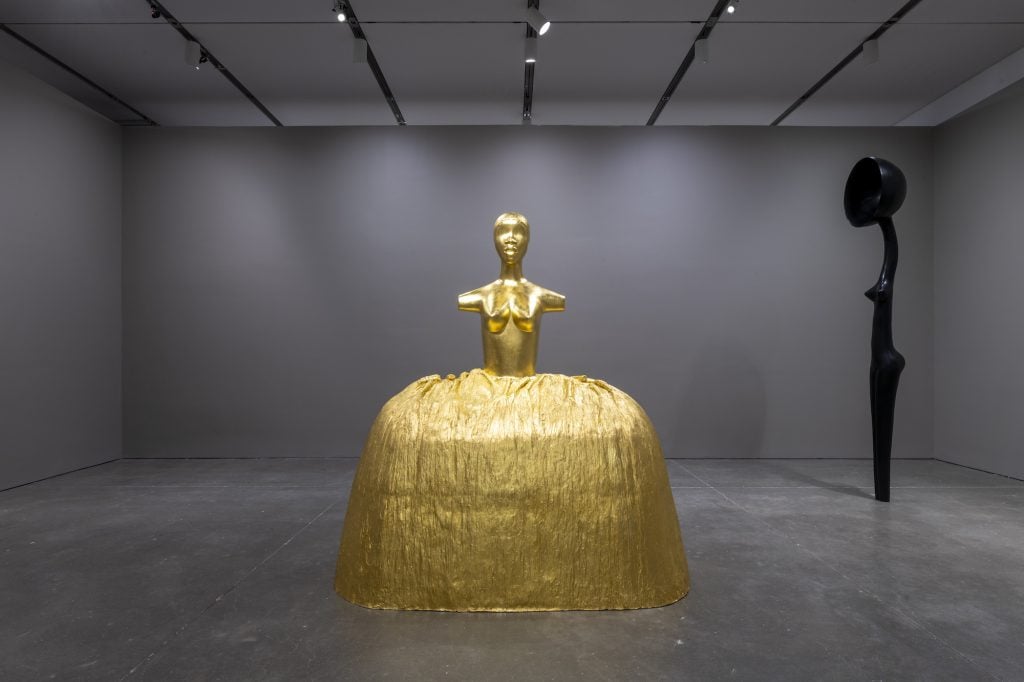
ICA Boston is currently exhibiting works from Simone Leigh's 2022 Venice Biennale in the U.S. for the first time.

Katie White

Raffia skirts, rosebud hair knots, abstracted, eyeless faces, and the Black female body are the elemental components of American artist Simone Leigh’s (b. 1967) distinct visual language, a language the artist has crafted to fluency over the past two decades of her career.
Over the years, Leigh’s artworks have earned widespread critical and public acclaim with solo exhibitions at New York’s New Museum of Contemporary Art, the High Line, the Hammer Museum in Los Angeles, and the Perez Art Museum in Miami. Last summer, in a career-crowning achievement, Leigh represented the United States at the 2022 Venice Biennale. Her presentation, “Sovereignty,” filled the pavilion’s Neoclassical structure with a striking set of new sculptures made of age-old materials of bronze and ceramic, merging architectural structures with the female body, in powerful statements on Black women’s labor, cultural transmission, and hierarchies of power. The stunning presentation won Leigh the Golden Lion, the biennale’s highest honor.
Now, the American public will have the chance to see many of these works in the U.S. for the first time. The ICA Boston recently opened the much-anticipated exhibition “Simone Leigh,” curated by Eva Respini, deputy director of curatorial affairs, and Anni A. Pullagura, curatorial assistant. Here, 11 works from Venice form the nucleus of an expanded survey of 29 works across ceramic, bronze, and video.
“It’s a privilege to be able to go to Venice. A very small number of people can do that and so we felt it was important to bring the works here, to have U.S. audiences be able to enjoy it. And while the show is certainly a celebratory homecoming, we’ve also created a context for those works within a broader context of her career,” said Respini in a conversation. Following ICA Boston, the exhibition will travel to the Hirshhorn Museum and Sculpture Garden in Washington, D.C., and Los Angeles for a joint presentation with LACMA and the California African American Museum.
If you’re new to Simone Leigh’s work or simply curious about the exhibition, we’ve chosen what we consider to be 5 essential artworks in the exhibition, which unlock insights into Leigh’s larger practice. Read below to find out more.
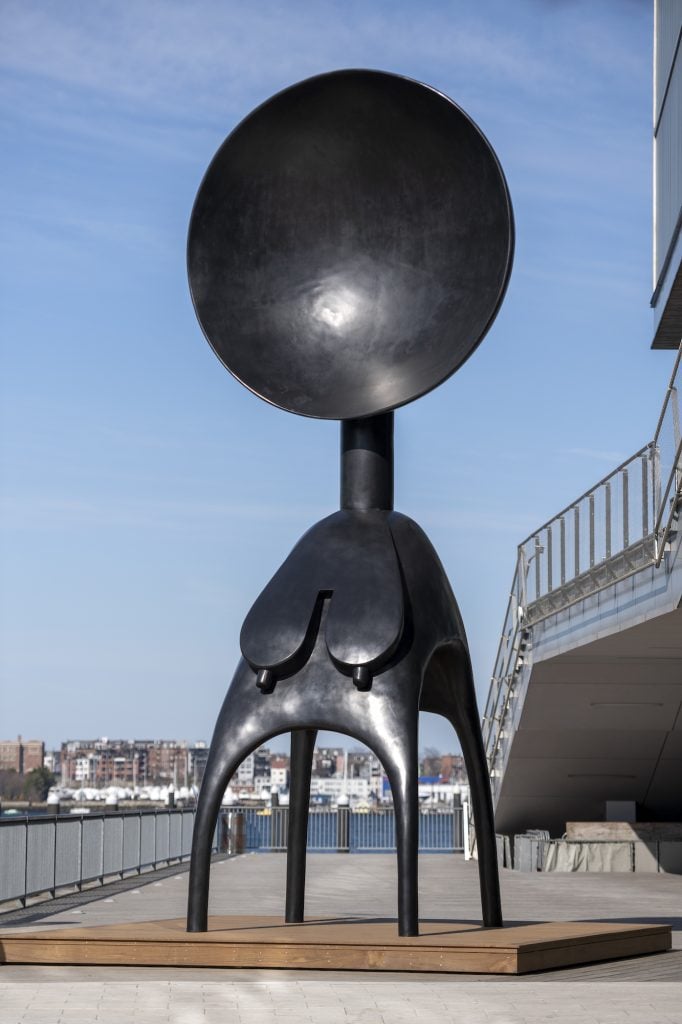
Installation view of Simone Leigh’s Satellite (2022) at the Institute of Contemporary Art/Boston, 2023. Courtesy of the artist and Matthew Marks Gallery. Photo by Timothy Schenck. © Simone Leigh.
Just the Facts: Before visitors even reach the ICA, they are met by the monumental bronze, Satellite, which towers 24 feet tall, installed outside the museum. Satellite is particularly representative of the ways Leigh explores and combines materials and cultural histories; the figure is inspired by a D’mba, a wooden headdress with a female bust belonging to the Baga people of the Guinea Coast. These headdresses were traditionally worn ceremonially as a conduit between the living and the dead. In Leigh’s sculpture, the head is replaced by a large bronze satellite dish.
Expert Insights: “Simone’s works are always hybrids in many ways of the cultural and material histories of the African diaspora, the African continent, the Caribbean as well the U.S. Here, she has taken this idea of the headdress, and blown it up to a monumental scale, but in place of a head has cast a satellite dish that is 10 feet across, bringing in a very modern and contemporary conduit. Satellite dishes are built for both receiving and broadcasting. And so that satellite dish, in a way becomes a beacon that not only broadcasts outwards but also receives all of those who come to the show,” said curator Eva Respini.
Bonus Material: In Venice, Satellite stood majestically at the center of the U.S. pavilion’s courtyard. In this installation, the sculpture, marked by its beautiful black patina, is installed along the Boston Harbor and can be seen from several blocks away, welcoming visitors to the museum.
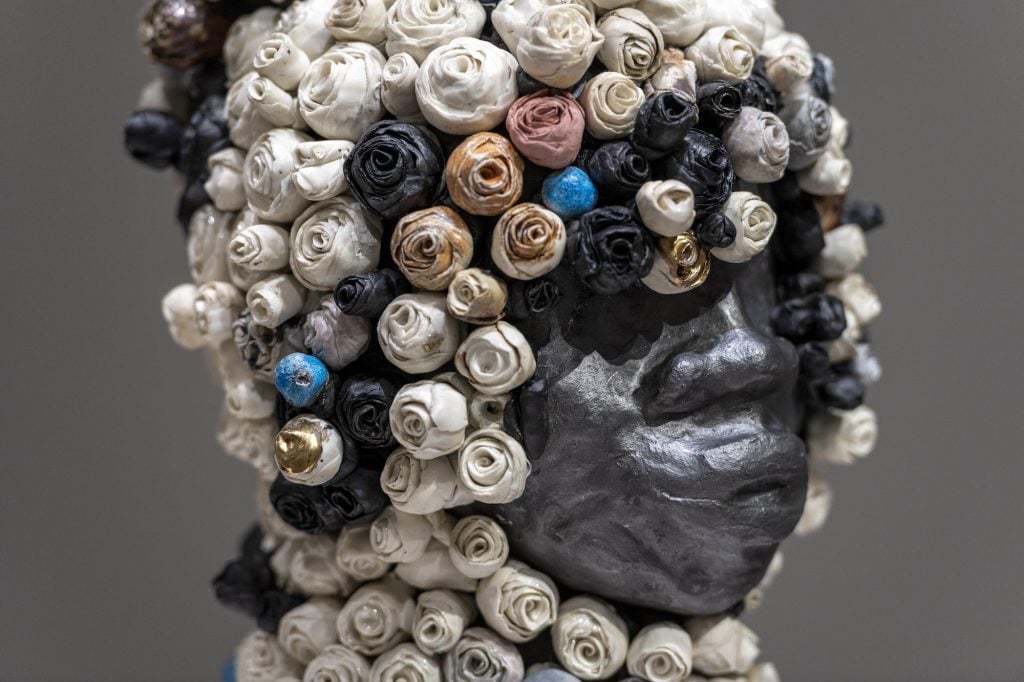
Simone Leigh, Overburdened with Significance (2011). Photo by Timothy Schenck. © Simone Leigh.
Just the Facts: Simone Leigh first rose to acclaim for her busts and heads, which reinterpret the classical motif. Overburdened with Significance is among the earliest heads Leigh created, here defined by an elongated hairstyle composed of glazed rosettes in white, gray, and tan. The figure’s abstracted face will be recognizable to those familiar with Leigh’s work–and is eyeless, as is also common to her works. Such depictions have at times been interpreted as a refusal of a gaze or an inward look, but also speak to Leigh’s interest in the abstraction of the body.
Expert Insights: “The narrative of labor is very prominent throughout Simone’s work, specifically the idea of anonymous and unrecognized labor, specifically the labor of Black women’s intellectual labor, as well as creative or domestic labor. And so, for me, the rosettes of Overburdened with Significance are not only a motif that she has come back to again and again, but I feel like I can see her making them and I look at the work, that they embody the act of making and very tactile and haptic. Of course, people shouldn’t touch! But this work has the kind of texture and tactility that is what makes her work so resonant,” said Respini.
Bonus Material: Leigh handcrafts each and every rosette, rolling clay between her fingers to form each petal.
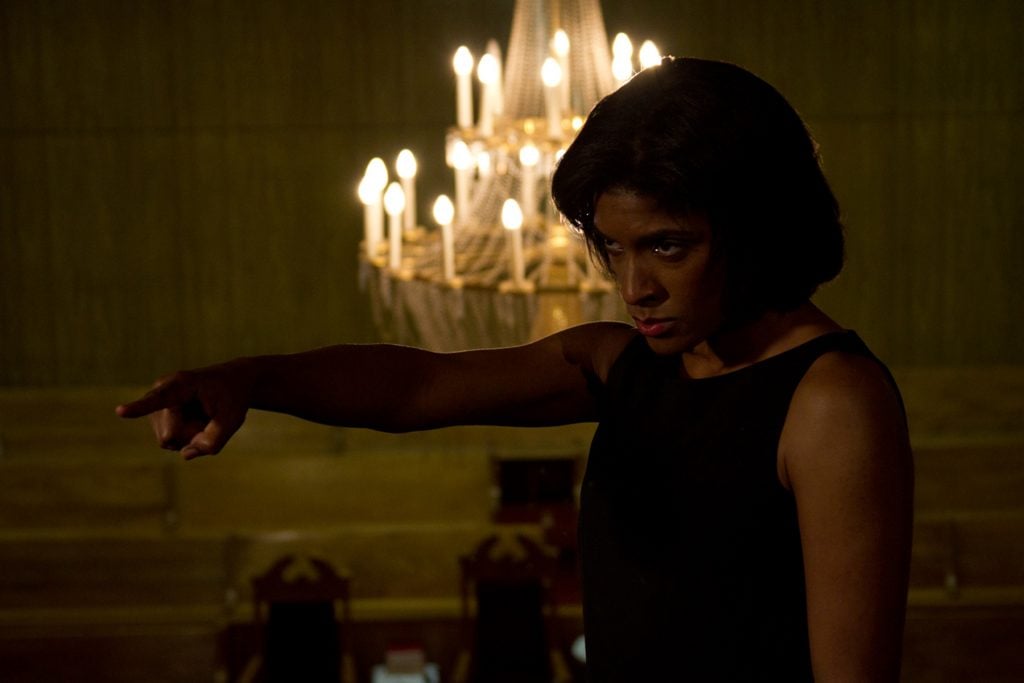
Liz Magic Laser and Simone Leigh, in collaboration with Alicia Hall Moran, Breakdown (2011). Courtesy of the artists and Matthew Marks Gallery.
Just the Facts: Though not as widely familiar as her sculptures, Leigh has frequently collaborated with other artists in creating video works. The ICA exhibition features three of these video works, including Breakdown (2011) made with artist Liz Magic Laser with composer and musical artist Alicia Hall Moran. The 9-minute single-channel color video features Moran, a mezzo-soprano, singing a libretto of a “hysterical” breakdown, the language culled from fictional scenes of women crying in both television shows and movies. The results film is a moving, tragicomic mediation on psychology, race, and gender.
Expert Insights: “We put ‘hysterical’ in quotes here because it’s really about the roles that women are forced to play and the stereotypes that women have been pushed into. Hysteria in this 19th-century sense is perceived as performative and in this work, Alicia does a beautiful performance that’s very expressive and intense. The volume of her voice and the cadence of it really sort of embodies the libretto and reverberates through the rafters of the Harlem church where this was filmed. Breakdown really underscores the many different arenas, Simone is drawing from and her interest in pushing forward the work of other creators,” said Respini.
Bonus Material: Moran’s character’s breakdown is spurred by a quite mundane inconvenience: she doesn’t want to attend a ballgame.
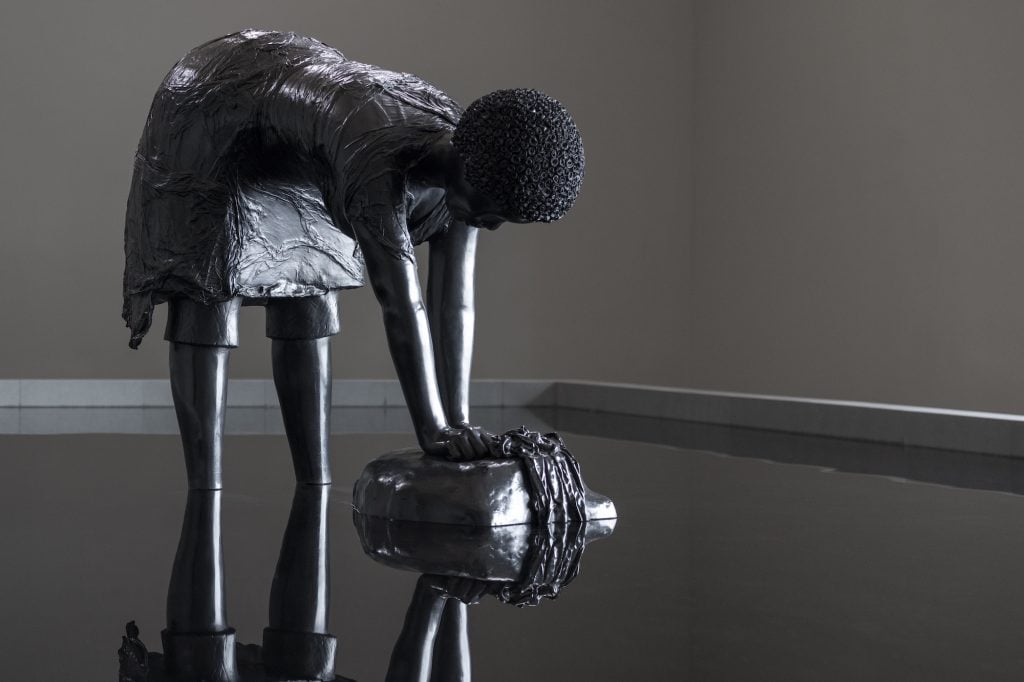
Simone Leigh, Last Garment (2022). Installation view at “Simone Leigh,” the Institute of Contemporary Art/Boston, 2023. Courtesy of the artist and Matthew Marks Gallery. Photo by Timothy Schenck. © Simone Leigh.
Just the Facts: This bronze sculpture (measuring approximately 4.5 by 5 feet) has a concrete inspiration—a 19th-century souvenir photograph that depicts an anonymous Jamaican laundress, bent washing clothes in a river. Such souvenir photographs were used by tourism bureaus to attract visitors to the British West Indies and in this case Jamaica. Last Garment reflects upon these visual histories of labor, specifically, the anonymous labor of Black women, giving permanence to this figure.
Expert Insights: “Simone has intervened and rethought the laundress’s anonymity by giving her a grand scale through this larger-than-life representation made in beautiful and durable bronze. What’s most captivating to me is the incredible attention to detail Leigh brings to this sculpture, in particular the figure’s hair, which is made of almost 800 individual rosettes. Even working at this scale, Leigh brings details to the fore, giving the sculpture an incredible impact in person,” said Anni Pullagura.
Bonus Material: The sculpture is meant to be presented with a reflecting pool, as it was in Venice. Here in the ICA installation, a new, larger reflecting pool has been created for Last Garment, one that is situated breathtakingly along the sightline of Boston Harbor outside.
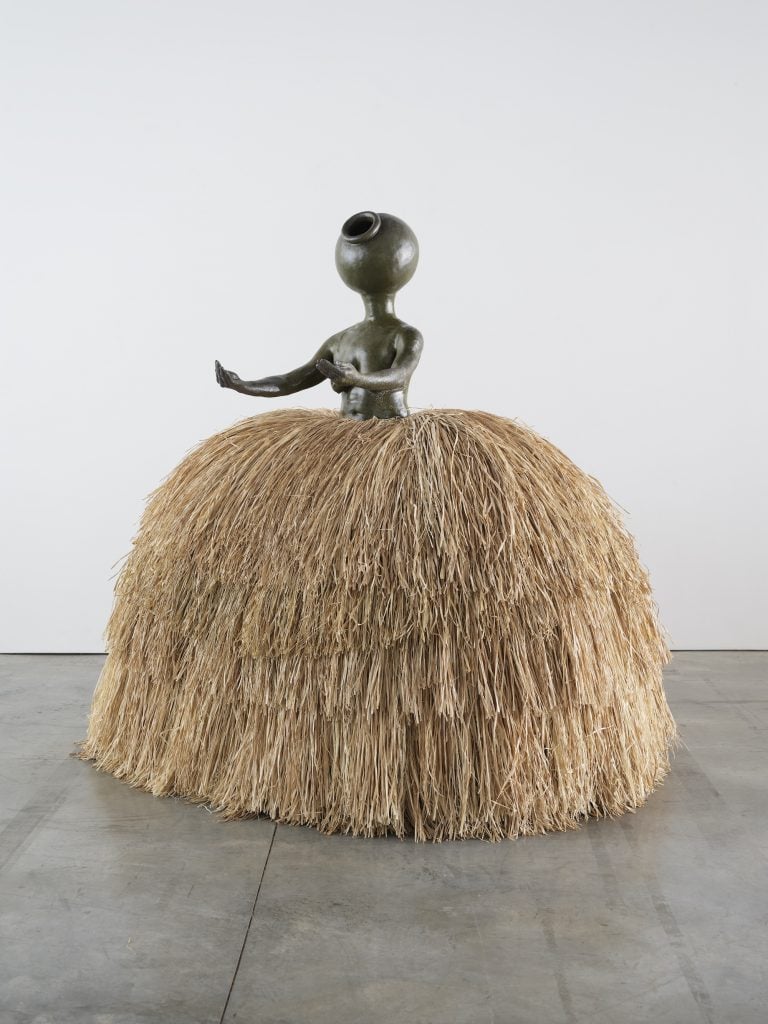
Simone Leigh, Cupboard IX (2019). Courtesy of the artist. © Simone Leigh.
Just the Facts: In Leigh’s more recent large-scale ceramic sculptures, bodily elements often fuse with familiar household domestic storage objects, in this case, a cupboard. Cupboard IX, a towering sculpture, which measures 6.5 feet tall, presents a faceless head atop a woman’s torso, whose arms are outstretched in a gesture of welcoming. This upper body is ceramic and fired with a luminous green tea glaze. The head is in the shape of a pot—a vessel we might imagine collecting water or as storage for grain. Still yet, one might picture a woman walking with a pot on top of her head. All these allusions lead back to one of Leigh’s more central symbols: woman as nourisher. This upper torso is affixed to a steel armature overlaid with a raffia skirt. Raffia skirts appear in many of Leigh’s works, signaling motherhood and femininity, along with architecture and Sub-Saharan dwellings. In this way, Cupboard IX brings together many of the motifs that reconfigure throughout her oeuvre. Leigh has said that she creates for an audience of Black women and femmes, and through works like Cupboard IX she speaks to their community roles, as providers and protectors.
Expert Insights: “The dome shape form reads as a skirt, but it also reads as a structure. It could be a reference to Muskoka architecture or Sub-Saharan architecture. You could think of it as a hut, perhaps, but also as a place of refuge. The idea of hiding under your mother’s skirts, comes to mind. The femme body appears here as a place of gathering, a place of safety and welcoming, which is echoed again in the gesture of outstretched arms,” said Respini.
Bonus Material: Raffia comes from a palm tree native to Madagascar and is used in many contexts within the African continent including housing and basket weaving. It can be found all throughout the Global South, however, in the Caribbean, and in East Asia.